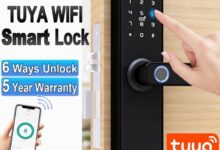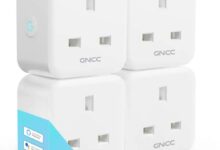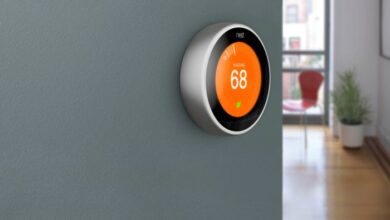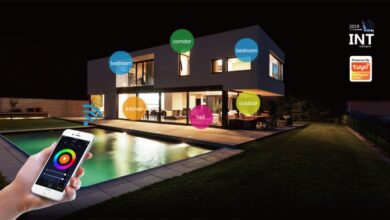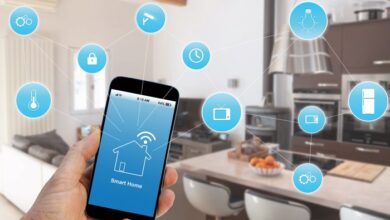Home Automation Systems A Smart Home Guide
Home Automation Systems are revolutionizing how we live, transforming houses into responsive, interconnected ecosystems. Imagine a home that anticipates your needs, adjusting lighting, temperature, and security with seamless precision. This isn’t science fiction; it’s the reality of home automation, a field blending cutting-edge technology with everyday convenience. We’ll delve into the intricacies of different system types, essential components, and the crucial considerations for security and privacy.
Get ready to unlock the potential of a truly smart home.
From choosing between centralized and decentralized systems to understanding the nuances of Z-Wave, Zigbee, and Wi-Fi protocols, we’ll navigate the complexities of home automation. We’ll explore the hardware—hubs, sensors, actuators—and the software that brings it all together. Learn how to integrate your smart devices, troubleshoot connectivity issues, and future-proof your smart home investment. This comprehensive guide will empower you to design, install, and maintain a secure and efficient home automation system.
Types of Home Automation Systems
Home automation, the ability to control your home’s devices and systems remotely, has evolved significantly. From simple smart bulbs to complex integrated systems, the choices available can feel overwhelming. Understanding the different types of systems, their functionalities, and their pros and cons is crucial for making an informed decision that best suits your needs and budget. This exploration will clarify the key distinctions and help you navigate the world of home automation.
Centralized vs. Decentralized Home Automation Systems
Centralized systems utilize a single hub or controller as the brain of the operation. All devices connect to this central point, which manages communication and control. Think of it like a central nervous system for your home. Decentralized systems, on the other hand, lack a central hub. Instead, devices communicate directly with each other or through smaller, localized networks.
This approach offers greater resilience to failure; if one device malfunctions, the entire system isn’t necessarily affected. However, centralized systems generally offer more seamless integration and centralized control. The choice between these architectures often depends on the scale and complexity of the home automation setup. A smaller home might find a decentralized system sufficient, while a larger, more complex setup would likely benefit from the organization and control of a centralized system.
Functionalities of Different System Types
Several communication protocols underpin home automation systems. Z-Wave, for instance, uses low-power radio frequencies for reliable communication, even through walls. This makes it ideal for connecting a wide range of devices across a home. Zigbee, another popular protocol, is also low-power and efficient, focusing on mesh networking – meaning devices can relay signals to each other, extending the network’s reach.
Wi-Fi, while convenient for its ubiquity, can be less reliable for home automation due to interference and higher power consumption. Each protocol offers unique advantages and disadvantages, influencing the choice of devices and overall system performance. The selection of a protocol will often depend on the specific needs and existing infrastructure of a home. For example, a home with extensive pre-existing Wi-Fi infrastructure might favor Wi-Fi-based automation, whereas a new construction might benefit from a more robust and interference-resistant protocol like Z-Wave.
Wired vs. Wireless Home Automation Systems
Wired systems, using traditional cabling like Ethernet or low-voltage wiring, offer superior reliability and speed, but installation can be expensive and intrusive. Wireless systems, leveraging technologies like Wi-Fi, Z-Wave, or Zigbee, are easier and cheaper to install, providing flexibility and mobility. However, wireless systems are susceptible to interference and signal degradation, potentially leading to connectivity issues. The choice often depends on the existing home infrastructure, budget, and desired level of reliability.
A retrofitted older home might favor the flexibility of a wireless system, while a new construction could leverage wired systems for enhanced reliability and speed.
Comparison of Home Automation Systems
Choosing the right system depends on your needs and budget. Here’s a comparison of four popular options:
| System | Cost | Compatibility | Key Features |
|---|---|---|---|
| SmartThings | Mid-range | Wide range of devices and protocols | Centralized hub, robust app, IFTTT integration, voice control |
| Home Assistant | Low to mid-range (open-source) | Highly customizable, supports many protocols | Open-source, flexible, advanced automation capabilities |
| Apple HomeKit | Mid-range to high-range (dependent on device selection) | Primarily Apple devices and accessories | Seamless integration with Apple ecosystem, strong security |
| Amazon Alexa | Variable (depending on device selection) | Wide range of smart home devices, but primarily voice-controlled | Voice control, extensive skill set, integration with other services |
Key Components of Home Automation Systems

A seamless home automation experience hinges on a carefully orchestrated interplay of hardware, software, and network infrastructure. Understanding these core components is crucial for designing a system that meets your specific needs and operates reliably. This section will delve into the essential elements that make up a robust and efficient home automation setup.
Essential Hardware Components
The physical building blocks of your smart home are diverse, each playing a unique role in translating your commands into actions. These components work in concert to monitor, control, and automate various aspects of your home environment. Without them, the sophisticated software and applications are rendered useless.
- Hubs: The central nervous system of your home automation network, hubs act as the communication center, connecting all your smart devices and enabling them to interact. Examples include Amazon’s Echo, Google Home, or Samsung SmartThings. These hubs often utilize different communication protocols, such as Zigbee, Z-Wave, or Wi-Fi, to interact with connected devices. Choosing a hub with broad compatibility is vital for seamless integration of various smart devices.
- Sensors: These devices are the eyes and ears of your smart home, constantly monitoring various conditions. Motion sensors detect movement, triggering lights or security systems. Temperature sensors provide data for automated climate control. Door/window sensors alert you to intrusions or ensure that lights automatically switch off when a room is empty. The diversity of sensors available allows for comprehensive monitoring of your home’s environment.
- Actuators: Actuators are the muscles of your smart home, translating the data received from sensors and commands from your control system into physical actions. Smart switches control lighting, smart plugs manage power to appliances, and smart thermostats regulate temperature. Motorized blinds and curtains add another layer of automated control to your home environment, providing convenience and energy efficiency.
The Role of Software and Applications
Beyond the physical components, the software and applications form the brain of your home automation system. These are the interfaces through which you interact with your smart home, configure settings, and monitor its operation. Robust software is crucial for a user-friendly and reliable experience.The software acts as a translator between you and the hardware. It receives your commands, processes them, and sends instructions to the actuators through the hub.
Simultaneously, it collects data from sensors, making this data readily accessible through user-friendly interfaces such as mobile apps or web dashboards. A well-designed application allows for intuitive control, scheduling, and monitoring of your smart home devices, providing a seamless user experience. Consider the scalability and features offered by different platforms before making your selection. For instance, some platforms offer advanced automation rules and integrations with third-party services, allowing for a highly customized and personalized smart home experience.
Network Infrastructure for Reliable Operation
A reliable network infrastructure is paramount for a smooth-running home automation system. The constant exchange of data between sensors, actuators, and the central hub requires a stable and robust network connection. A weak or unreliable network can lead to connectivity issues, malfunctions, and overall frustration.A strong Wi-Fi signal throughout your home is essential, ensuring that all connected devices can communicate effectively with the hub.
Consider using a mesh Wi-Fi system to extend the reach of your network and eliminate dead zones. Furthermore, a wired connection for the hub itself can provide a more stable and reliable connection, minimizing the risk of interruptions. Regular network maintenance, such as checking for interference and updating your router’s firmware, is also crucial for maintaining optimal performance.
Investing in a high-quality router and strategically placing access points can significantly enhance the reliability of your home automation system.
A Basic Home Automation Setup
Imagine a simple setup incorporating a smart lighting system. This would involve a central hub (e.g., a smart speaker with built-in home automation capabilities), smart bulbs in key rooms, and a motion sensor in the hallway. The motion sensor detects movement, sending a signal to the hub. The hub then instructs the smart bulbs in the hallway and adjacent rooms to illuminate, providing convenient and automated lighting.
This basic setup demonstrates the interconnectedness of hardware and software, highlighting the synergy between sensors, actuators, and the central control system. Expanding this setup to include smart thermostats, security systems, and other smart devices is straightforward, demonstrating the scalability and adaptability of home automation systems.
Smart Home Device Integration
Building a truly effective smart home hinges on seamless integration between your various devices. While the promise of a connected home is alluring, the reality often involves navigating compatibility challenges and troubleshooting connectivity issues. Understanding these hurdles and employing effective strategies is crucial for realizing the full potential of your home automation system.The ability to effortlessly control and monitor various aspects of your home from a single interface is a key benefit of home automation.
However, achieving this interconnectedness isn’t always straightforward. Different devices often operate on different protocols and platforms, leading to compatibility problems that can range from minor inconveniences to complete system failures.
Compatibility Issues in Smart Home Device Integration
Compatibility problems arise from the diverse technologies employed by different smart home manufacturers. Some devices utilize proprietary protocols, limiting their interoperability with others. For example, a smart lock from one brand might not be compatible with a home security system from another. Furthermore, the use of different communication standards, such as Zigbee, Z-Wave, Wi-Fi, and Bluetooth, can create significant integration challenges.
The lack of standardization across the industry often results in devices that simply refuse to communicate with each other, hindering the creation of a cohesive and efficient smart home ecosystem. This necessitates careful planning and research before purchasing any smart home devices to ensure they will work together harmoniously.
Examples of Successful Device Integrations and Their Benefits
Successful smart home integrations often leverage open standards or cloud-based platforms that act as intermediaries. For instance, integrating a smart thermostat (like Nest) with a smart speaker (like Amazon Echo) allows for voice control of temperature settings. This integration offers convenience and enhances user experience by providing a hands-free method for adjusting the home’s temperature. Similarly, linking a smart lighting system (like Philips Hue) with a smart security system can trigger lights to illuminate upon detecting motion, enhancing home security.
This integration adds a layer of proactive security, deterring potential intruders and providing peace of mind. The benefits of successful integrations extend beyond convenience; they often enhance energy efficiency, improve security, and offer a more personalized and intuitive home environment.
Troubleshooting Connectivity Problems Between Smart Home Devices
Connectivity problems are common in smart home setups. Troubleshooting typically involves checking the device’s power source, ensuring proper network connectivity (Wi-Fi signal strength, router configuration), and verifying the devices are correctly added to the home automation hub or app. Restarting devices, checking for firmware updates, and ensuring compatible communication protocols are in use are other crucial steps. For persistent issues, consulting the manufacturer’s support documentation or contacting customer service can provide valuable assistance.
In some cases, a professional smart home installer might be needed to resolve complex integration challenges. A methodical approach to troubleshooting, starting with the simplest solutions and progressively addressing more complex issues, is essential for resolving connectivity problems.
Popular Smart Home Devices and Their Capabilities
Before integrating smart devices, understanding their individual capabilities within a home automation system is vital.
- Smart Speakers (e.g., Amazon Echo, Google Home): Voice control of various smart home devices, music playback, information retrieval, and more. They act as central control hubs for many systems.
- Smart Thermostats (e.g., Nest, Ecobee): Automated temperature control, energy efficiency features, and remote monitoring and adjustment.
- Smart Lighting (e.g., Philips Hue, LIFX): Controllable lighting color, brightness, and scheduling, offering customizable ambiance and energy savings.
- Smart Locks (e.g., August, Schlage): Remote locking/unlocking, keyless entry, and integration with home security systems.
- Smart Security Systems (e.g., Ring, SimpliSafe): Motion detection, intrusion alerts, video surveillance, and integration with other smart home devices for enhanced security.
Security and Privacy Considerations: Home Automation Systems
The convenience and efficiency offered by home automation systems come with inherent security and privacy risks. Understanding these vulnerabilities and implementing robust mitigation strategies is crucial for protecting your home and personal data. Failing to do so could expose you to a range of threats, from unauthorized access to your devices and systems to identity theft and financial loss.
This section explores the key security and privacy challenges and provides practical steps to safeguard your smart home.
Home automation systems, by their nature, connect numerous devices to a central network, creating a larger attack surface. A single vulnerability in one device can potentially compromise the entire system. This interconnectedness, while beneficial for functionality, significantly increases the potential for breaches. For example, a compromised smart lock could grant physical access to your home, while a vulnerable smart camera could expose sensitive information or even allow remote surveillance.
Security Risks and Mitigation Strategies
Several security risks are associated with home automation systems. These range from simple password vulnerabilities to sophisticated attacks targeting system flaws. Effective mitigation involves a multi-layered approach encompassing hardware, software, and user practices.
- Weak Passwords and Default Credentials: Many users fail to change default passwords on their smart home devices. This provides an easy entry point for attackers. The solution is to use strong, unique passwords for each device and regularly update them. Consider using a password manager to streamline this process.
- Unpatched Software: Outdated software often contains known vulnerabilities that attackers can exploit. Regularly updating firmware and software on all devices is paramount to minimizing this risk. This includes not only the primary hub but also individual smart devices like lights, thermostats, and security systems.
- Network Vulnerabilities: A poorly secured home network can provide a gateway for attackers to access your smart home devices. Using a strong Wi-Fi password, enabling encryption (WPA2/WPA3), and regularly updating your router’s firmware are essential steps. Consider using a VPN for added security.
- Phishing and Social Engineering: Attackers may attempt to gain access to your system through phishing emails or other social engineering tactics. Users should be vigilant about suspicious emails and messages and never click on links or download attachments from unknown sources.
Data Encryption and Secure Communication Protocols, Home Automation Systems
Protecting data transmitted between devices and the cloud is crucial. Strong encryption protocols ensure that even if data is intercepted, it remains unreadable to unauthorized individuals. Secure communication protocols, such as TLS/SSL, are essential for protecting sensitive information during transmission.
Using end-to-end encryption whenever possible is a best practice. This ensures that only the sender and receiver can access the data, even if the communication channels are compromised.
Privacy Concerns Related to Data Collection and Usage
Many smart home devices collect significant amounts of data about user behavior and preferences. This data can include location information, energy consumption patterns, and even voice recordings. It’s crucial to understand how this data is collected, stored, and used. Review the privacy policies of each device and service carefully to understand the implications.
- Data Minimization: Only use smart home devices that collect the minimum necessary data. Disable unnecessary data collection features whenever possible.
- Data Transparency: Choose devices and services from companies with transparent data practices. Look for companies that clearly explain how they collect, use, and protect user data.
- Data Security: Ensure that the companies handling your data have robust security measures in place to protect it from unauthorized access or breaches.
Best Practices for Securing a Home Automation System
Implementing a comprehensive security strategy involves a combination of technical measures and responsible user behavior. This guide Artikels key best practices to minimize risks and maximize the security of your smart home.
- Strong Passwords and Multi-Factor Authentication (MFA): Utilize strong, unique passwords for each device and enable MFA whenever possible. MFA adds an extra layer of security by requiring a second form of authentication, such as a code sent to your phone.
- Regular Software Updates: Keep all devices and software updated with the latest security patches. This is a critical step in mitigating vulnerabilities.
- Secure Network Configuration: Use a strong Wi-Fi password, enable encryption, and regularly update your router’s firmware. Consider segmenting your network to isolate smart home devices from other sensitive devices.
- Firewall Protection: A firewall can help to block unauthorized access attempts to your network and devices.
- Regular Security Audits: Periodically review the security settings of your smart home devices and network to identify and address any potential vulnerabilities.
- Privacy Settings: Carefully review and adjust the privacy settings of each device to control the type and amount of data collected.
Home Automation System Installation and Setup
Setting up a home automation system can seem daunting, but with a methodical approach, it’s a manageable DIY project that can significantly enhance your home’s comfort and security. This section provides a step-by-step guide to installing a basic system, configuring smart devices, and optimizing performance for a seamless experience. Understanding the process will empower you to transform your house into a smart home, effortlessly managing various aspects of your living space.
The installation process largely depends on the complexity of your chosen system and the number of devices you intend to integrate. However, the core principles remain consistent. Whether you’re working with a Z-Wave, Zigbee, or Wi-Fi-based system, careful planning and execution are crucial for a successful outcome.
System Requirements and Planning
Before beginning installation, meticulously plan your system’s layout. Identify the location of each smart device – lights, thermostats, security sensors, etc. – and consider their power sources and network connectivity. This planning phase minimizes disruptions and ensures a smooth installation process. A well-thought-out plan will save you time and potential headaches down the line.
For instance, mapping out your network’s Wi-Fi coverage is vital for ensuring reliable connectivity for all your devices. Consider using a Wi-Fi extender if necessary to eliminate dead zones.
Step-by-Step Installation Process
Installing a basic home automation system typically involves several key steps. This process assumes a pre-existing home network and readily available power outlets. Remember to consult your individual device manuals for specific instructions.
- Network Setup: Ensure your home Wi-Fi network is strong and stable. Consider upgrading your router if necessary for optimal performance. Note down your network name (SSID) and password, as you’ll need this information to connect your smart devices.
- Hub Installation: If your system uses a central hub (many do), install it according to the manufacturer’s instructions. This often involves connecting it to your router via Ethernet and powering it on.
- Device Pairing: Follow the instructions provided with each smart device to connect it to the hub or directly to your Wi-Fi network. This usually involves downloading a mobile app and following on-screen prompts. For example, a smart light bulb might require you to screw it into a socket, then add it to your home automation app through a unique code.
- System Testing: After installing all devices, thoroughly test the system to ensure everything is functioning correctly. Try controlling devices remotely using the app to verify connectivity and responsiveness. This step is crucial for identifying any potential issues early on.
Smart Home Device Configuration and Programming
Configuring and programming smart devices involves customizing their settings and behavior according to your preferences. This often involves using a dedicated mobile application or a web interface provided by the manufacturer. This allows you to tailor the functionality of your devices to your specific needs and lifestyle.
For example, you can set up automated routines (like turning off lights at a specific time) or create scenes (combining multiple devices for a specific effect, such as “Movie Night” which dims the lights and turns on the TV). The level of customization varies depending on the device and the platform you are using. Many systems allow for advanced programming using scripting languages or integrations with third-party services.
Optimizing Home Automation System Performance
Optimizing your home automation system’s performance ensures smooth operation and prevents connectivity issues. This involves several strategies that can significantly improve the overall user experience.
- Regular Software Updates: Keep your hub’s firmware and individual device software updated. Updates often include bug fixes and performance enhancements. Ignoring updates can lead to compatibility problems and security vulnerabilities.
- Network Optimization: Ensure your Wi-Fi network is robust and covers your entire home. Use a network analyzer to identify potential bottlenecks or weak signals. Consider adding Wi-Fi extenders or mesh networks for better coverage.
- Device Placement: Strategically place your devices to optimize signal strength. Avoid placing devices behind walls or large metal objects that can interfere with wireless signals.
Visual Representation of Home Automation System Installation
Imagine a flowchart depicting the installation process. It starts with a central box representing the home automation hub, connected to a router symbolized by a small wireless antenna. Branching out from the hub are several lines, each representing a different smart device. These lines are labeled with the type of device (e.g., smart light, smart thermostat, security sensor).
Each device is represented by a simple icon. Arrows show the flow of data between the devices and the hub. Finally, a smartphone icon is connected to the hub, symbolizing the app used to control the system. The flowchart clearly illustrates the interconnected nature of the system and the role of the central hub in managing various devices. The overall visual is clean and easy to understand, highlighting the key components and their interactions.
Future Trends in Home Automation
The home automation landscape is rapidly evolving, driven by advancements in artificial intelligence, the Internet of Things (IoT), and increasingly sophisticated user interfaces. These changes promise to transform our homes into more efficient, responsive, and personalized environments, but also present unique challenges in terms of security, privacy, and accessibility. Understanding these trends is crucial for both consumers and industry players alike.
The convergence of AI, IoT, and advanced data analytics is poised to revolutionize how we interact with our homes. Imagine a system that learns your preferences, anticipates your needs, and proactively adjusts settings to optimize comfort and energy efficiency. This level of personalization and automation is no longer science fiction; it’s rapidly becoming a reality.
The Rise of Voice Control and Automation
Voice assistants, such as Amazon Alexa and Google Assistant, are already integral parts of many smart homes. However, the future will see even more seamless and intuitive voice control, moving beyond simple commands to complex, context-aware interactions. This includes more natural language processing, allowing for more nuanced instructions and proactive assistance. For example, instead of saying “turn on the lights,” you might say “it’s getting dark, can you please turn on the lights in the living room?” The system would then understand the context and execute the appropriate action.
Furthermore, voice control will extend beyond lighting and appliances to encompass security systems, entertainment, and even personalized health monitoring.
Artificial Intelligence and Machine Learning in Home Automation
AI and machine learning are set to significantly enhance the capabilities of home automation systems. AI-powered systems will learn individual user preferences over time, optimizing energy consumption, security protocols, and entertainment settings based on usage patterns. For instance, a smart thermostat might learn that you prefer a slightly cooler temperature in the evenings and automatically adjust accordingly. Similarly, smart security systems could learn to differentiate between familiar faces and potential intruders, reducing false alarms.
This predictive capability is a key differentiator, moving from reactive to proactive home management.
Challenges and Opportunities in the Home Automation Industry
The home automation industry faces several challenges, including interoperability issues between different devices and platforms, concerns about data security and privacy, and the need for user-friendly interfaces that are accessible to a wide range of users. However, these challenges also present significant opportunities for innovation and growth. The development of open standards and robust security protocols is crucial for building trust and ensuring widespread adoption.
Furthermore, the industry must focus on creating intuitive and accessible interfaces that cater to diverse user needs and technical skills. Companies that successfully address these challenges will be well-positioned to capitalize on the rapidly expanding market for smart home technology.
A Timeline of Advancements in Home Automation (Next 5-10 Years)
Predicting the future is always challenging, but based on current trends, we can expect several key advancements in home automation over the next 5-10 years:
- 2024-2026: Widespread adoption of AI-powered personalized automation; improved voice control and natural language processing; enhanced security features with improved biometric authentication.
- 2027-2029: Integration of home automation with other smart technologies (e.g., smart cars, wearable devices); increased focus on energy efficiency and sustainability; emergence of more sophisticated predictive maintenance features for appliances.
- 2030-2035: Proliferation of truly seamless and intuitive home automation systems; advanced home health monitoring capabilities; greater emphasis on user privacy and data security; potential for fully autonomous home management systems.
Conclusion
Building a smart home is more than just installing gadgets; it’s about creating a living space that adapts to your lifestyle, enhancing comfort, security, and efficiency. By understanding the different system types, components, and security protocols, you can design a home automation setup that meets your specific needs and budget. Remember, the future of home automation is bright, with advancements in AI and IoT promising even more innovative solutions.
Embrace the possibilities, and transform your house into a truly intelligent home.
